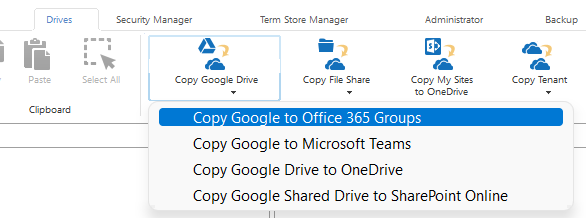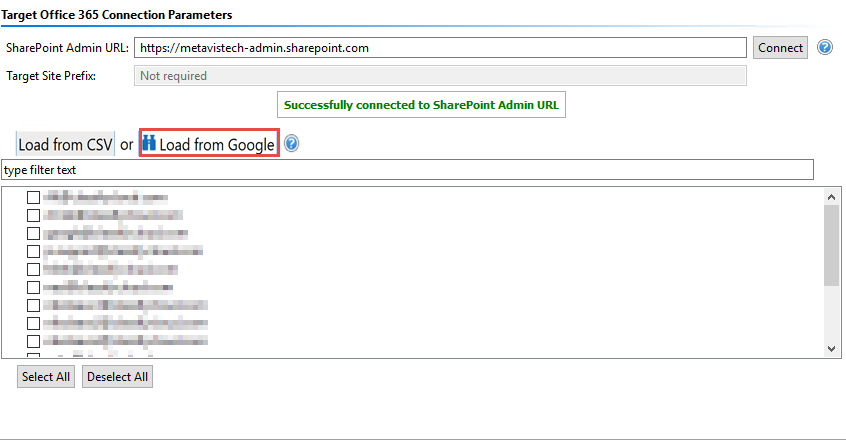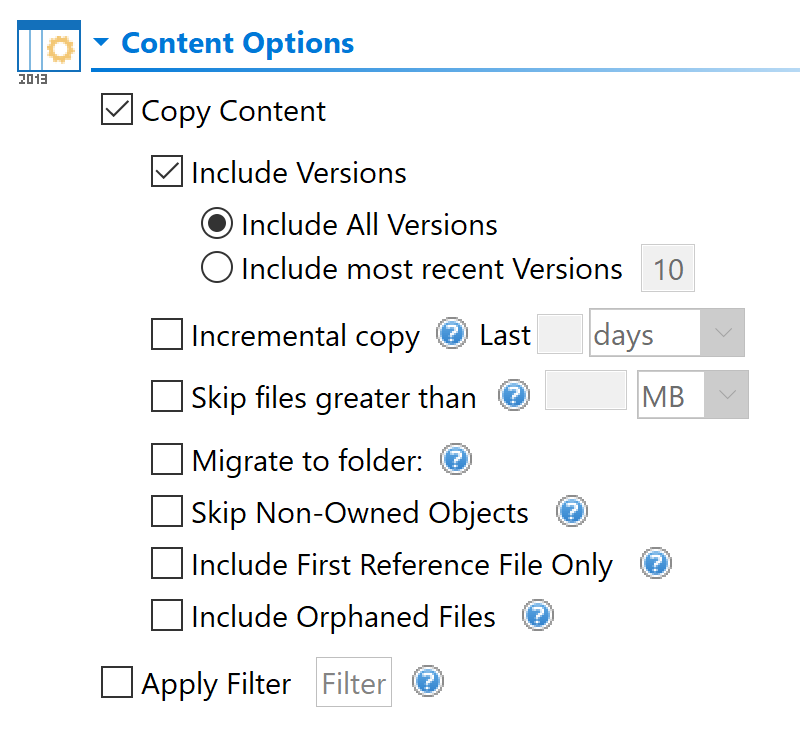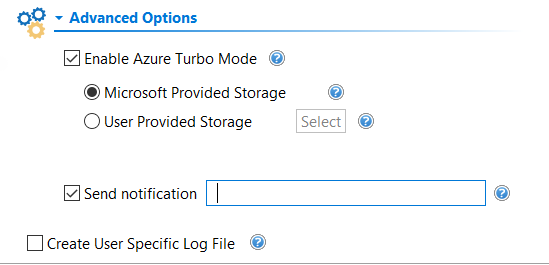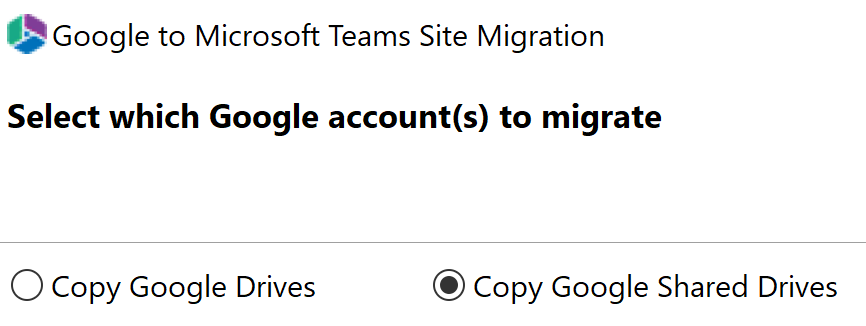Limitations When Migrating Google Drive to Office 365
The following Google Drive objects and scenarios are not supported when migrating to Office 365.
·Content scenarios
oContent within or shared from a user account which is currently in a "Suspended" state.
§To prevent duplicate files from being created, the option "Include First Reference File Only" has been added. When this option is enabled only the first returned reference of these linked files will be migrated. All other references will be skipped and an appropriate message will be added to the log file as shown below:
| "Skipped copying /GoogleDriveObjectPath because it is another reference object to a file and the option to include only the first reference was selected." |
oDocuments within a user's Google Drive that are owned by this user, but are not "Shared From" this user (this is related to the prior use of Google's "Transfer Ownership" function) will be skipped. This logic applies to documents only, folders will still be migrated.
·Folder colors
·Google Forms
·Google My Maps and other connected Apps
·Google Photos
·Inline file comments, except when migrating Google Docs, Sheets and Slides
·"Link sharing" settings are not retained
·Objects in the "Trash"
·Shared Permissions (Google Drive to Office 365 Group Sites only)
·Shared Permissions or meta-data associated with external users will not be retained.
·Starred or Favorite label on content
oThe item can be migrated, however this label is not retained.
·The migration of Google Shared Drive members to SharePoint Online.
|
|
NOTE: For Google Shared Drive items, the Google API does not populate the Owners property, which is mapped to the Created by property in Office 365. (This is documented in the Google Drive for Developers article Files | Drive API | Google Developers.) Therefore, Created by will always be set to the user currently logged into SharePoint. |
Additional Considerations When Migrating Google Drives to OneDrive for Business and SharePoint Online
In addition to Limitations When Migrating Google Drive to Office 365, following are additional considerations specific to migrations from Google Drive to OneDrive for Business and SharePoint Online.
Supported Content Types
The following Google Drive content types are supported when migrating to OneDrive for Business or SharePoint Online.
|
MIME Type |
Description |
|---|---|
|
application/vnd.google-apps.audio |
|
|
application/vnd.google-apps.document |
Google Docs |
|
application/vnd.google-apps.drawing |
Google Drawing |
|
application/vnd.google-apps.folder |
Google Drive folder |
|
application/vnd.google-apps.presentation |
Google Slides |
|
application/vnd.google-apps.spreadsheet |
Google Sheets |
|
application/vnd.google-apps.unknown |
|
|
application/vnd.google-apps.video |
|
Unsupported Content Types
The following Google Drive content types are not supported when migrating to OneDrive for Business or SharePoint Online.
|
MIME Type |
Description |
|---|---|
|
application/vnd.google-apps.form |
Google Forms |
|
application/vnd.google-apps.jam |
Google Jamboard |
|
application/vnd.google-apps.script |
Google Apps Scripts |
|
application/vnd.google-apps.shortcut |
Shortcut |
|
application/vnd.google-apps.site |
Google Sites |
Linked, Synchronized, and Reference Content
Content that is linked, synchronized or referenced in a second or more Google Drive folders will be copied as individual, discrete files to each of their respective locations in OneDrive for Business or SharePoint Online. Their linked, synchronized or referenced configuration from Google will not be maintained and duplicate files may therefore be created in OneDrive for Business or SharePoint Online.
The two link sharing options listed below will not be retained due to system-provided OneDrive for Business or SharePoint Online permissions.
§Anyone with the link
§Anyone at MyCompany with the link
The following error message will appear in the log when files with either of those link sharing options are processed:
Google "with the link" sharing was not processed on object /objectPath, and should therefore be manually recreated post migration.
Folder Naming
Each folder must have a unique display name to be migrated correctly.
|
|
NOTE: While Google Drive allows the creation of folders with spaces at the end of the name, OneDrive and SharePoint Online do not. Therefore, the space at the end of the name will be removed as part of the migration. |
Copy Google Drive to an Office 365 Group
This option allows administrators to move content from multiple Google Drives to Office 365 Group Sites default (Documents) library in a single operation.
|
|
NOTES: If you have not already performed the prerequisite steps in Google, please go to this section first. Once the prerequisite configuration is complete, return here to continue with the migration. |
This operation has the following requirements for use:
·The Google Drive pre-requisites must be configured successfully prior to the migration.
·The account used to perform the migration into Office 365 Groups needs to be a minimum of a Site Collection Administrator in this Office 365 tenant.
·The person performing the migration will need to know the relationship (user mapping) between each source Google Drive account and their corresponding Office 365 Group name and Office 365 user account.
·The Office 365 Group and its Site must already exist.
To migrate the content of multiple Google Drives to Office 365 Groups, perform the following:
1.On the Drives tab click Copy Google Drive and select "Copy Google Drive to Office 365 Groups".
The Google Drives to Office 365 Groups Migrator wizard opens.
2.Select the Copy Google Drives option.
3.Select a Profile and give your project a name.
4.Provide your Google Admin login, P12 Key File and Service Account in the Google connection parameters area. You can use the Google Mapping Report to gather this information. Once the values are entered, click Connect. If you receive any message other than Successfully connected to Google Drive, double check the prerequisite steps and then entered values. If you are still experiencing issues, please contact Support for assistance.
5.Specify your tenant SharePoint Administration Center URL and then click Connect. When prompted, enter your Administrator login and password. Click Connect. If you receive any message other than Successfully connected to SharePoint Admin URL, double check the URL and make sure you are supplying a Global Administrator login for this tenant. If you are still experiencing issues, please contact Support for further assistance.
6.Click the Load from Google button or Load From CSV. Note that Load from CSV will allow you to load users from a CSV file, which is the faster option as only the listed users are loaded (this CSV file can be created with the help of the Google User Mapping report).
Select the ones you want to include in this migration
|
|
NOTE: For a large number of Google Drives (>1000), the Load from Google option may take several minutes to complete. |
6.You can also choose to Load and Apply report option, which allows you to load and apply an Analyze Google Drive report, which then sets the Migration Priority for each user mentioned in the report. Click Next to continue.
|
|
NOTE: Each Migration Priority value can be changed if you click on the value in the Migration Priority columns (without user selection). It changes the migration queue but does not change the original report file. Priority in the wizard is not saved after the wizard has been closed. |
7.Check the Re-Map Users option and load your Group mapping CSV file (Please see this section for instructions on how to create a CSV Group Mapping file for Google Drive to Office 365 Group, user mapping may also be included in this CSV).
The CSV for Group mapping is required so that the software can properly resolve the differences between your users' Google account and the corresponding Office 365 Group name as well as maintain content authorship. If your user accounts differ between Google Drive and Office 365 then you will want to add your user mapping to this same file. In the example below, illustrate mapping a source Google Drive (network path) to an Office 365 Group (Office 365 Group Account).
C:\2015 Marketing Plan,MarketingGroup2015@contoso.com
X:\2016 Marketing Plan,MarketingGroup2015@contoso.com
\\home\users\jsmith\content\draft docs,AllGroup@contoso.com
8.Click Check Office 365 Groups in order to begin the validation process. This process will validate that the supplied user mapping is correct (Office 365 Groups were located) and check to determine if each Group currently has a Site provisioned. Click Next.
If the group is not found
|
|
NOTE: If a Group does not exist on the target then it will be created based on the original migration administrator. |
9.If necessary, change content and file format conversion options as described below.
Content Options
Copy Content - A flag to determine if content is or is not included with this operation. When not included the remainder of the options will become disabled.
Include Versions - The process in which Google revision history will be converted into Office 365 Group versions. Please note that this option is only referring to the major revisions (those shown as the "less detailed revisions") and not those that are automatically generated within Google Drives (those shown as the "more detailed" revisions).
Incremental Copy - When enabled, the migration process will identify and migrate only that content which was created, modified or versioned within the defined interval (days, weeks or months).
Skip files greater than - This provides the functionality to skip all files larger than the value specified. Unit of measure is configured for MB or GB.
Migrate to Folder - When this option is enabled you can create a (or use an existed) root folder structure in the destination library where your source content will be migrated.
Skipped Non-Owned Files - This addresses the possible scenario where content exists in the user's Google Drive "My Drive" area which is not owned by this user. Skipping these objects will prevent duplicate content from being migrated to the destination.
Include First Reference File Only - This option addresses the possible scenario where a user creates reference objects (links using Shift + Z in Google Drive) of a file in various locations throughout their Google Drive environment. Skipping these additional references will prevent duplicate files from being migrated to the destination by migrating only the first reference found. Please note that the "first" reference is defined by a list of parent folders returned from Google Drive and the first may not always be the same one on subsequent or incremental migrations. Please also note this option is only applicable to files, all referenced folders will be copied.
Include Orphaned Files - For the purpose of this option, an orphaned file is defined as a file that was created in a folder that was shared with this user and after the file was created, their permission to the shared folder was removed. The file still exists in the user's Google Drive, however it does not reside in any visible folder path and can only be located using the Google Drive Search Bar. When this option is enabled, the migration will identify these orphaned files and migrate them to the mapped Office 365 Group Site's Documents library. In this library, a new folder named "Orphaned Files" will be created which will contain all the migrated orphaned files.
|
|
NOTE: The use of this option can decrease overall migration performance. |
Apply Filter - Optionally, select from a series of filterable parameters to include or exclude specific content during migration.
Format Conversion:
This set of options allows you to determine how Google formatted content will be converted into Microsoft compatible content.
Advanced Options:
Enable Azure Turbo Mode: When enabled, this option utilizes Microsoft's SharePoint Online Migration API to increase the migration performance and throughput. A recommendation for optimal use of this API is larger sets of data; the more content, the better the throughput. Please review the User Manual for additional information as well as recommended configuration as this process is a resource intensive operation.
Because this API uses Azure storage as a staging area for the migration, it requires that you provide an Azure storage location. The options are to either utilize Microsoft supplied storage or to provide your own Azure storage location. If you wish to use your own Azure account, you must provide both the Azure Account Name as well as the corresponding Acces Key. If you cannot supply this information, please search our online Knowledge Base, User Manual or contact Support for additional information before proceeding or consider using the Microsoft Supplied Storage option. For more information please see the Azure Turbo Mode section.
|
|
NOTE: this function is optional and is only used to increase the migration performance to SharePoint Online or OneDrive for Business in Office 365. It does not provide any additional functionality that is not available when this option is disabled. |
·Microsoft Provided Storage: This option allows you to use Microsoft provided Azure storage instead of providing your own for the purpose of utilizing Azure Turbo Mode.
·User Provided Storage: This option allows you to provide your own Azure Storage instead of using one provided by Microsoft for the purpose of utilizing Azure Turbo Mode. It requires that you provide both your Azure Blob Storage Account Name as well as its corresponding Access Key by clicking the "Select" button to the right. If you cannot supply this information, please search our online Knowledge Base, User Manual or contact Support for additional information before proceeding.
|
|
NOTE: User Provided storage will give you access to Azure logs for a longer period of time than Microsoft provided storage. It will also allow you to perform the migration faster with less throttling. |
Send Notification: When selected, this feature will send emails to the listed recipients once Migrations are completed. Enter a specific user email address. For two or more, separate each email address with a comma. Set up User Notifications here in order to use this feature.
Create User Specific Log File - If you would like a user specific log file (.txt format) created for each migrated Google Drive, that will be saved directly to that Group's Documents library, check this option before you finish. This log file will contain all the content that was included in the migration with both source and target URLs as well as any file renaming that took place and skipped files due to lack of ownership.
NOTE: Create user Specific log file is disabled if Azure Turbo Asynchronous mode is on. Supported only for CSOM or Azure Turbo Synchronous modes.
|
|
NOTE: Content permissions are not migrated because Office 365 Group permissions are maintained and enforced by the group membership and its roles (Owners, Members and Guests). |
10. Click Finish to begin the migration process.
Please visit the following link to view the list of unsupported Google Drive objects.
Please visit the following link for an overview on how to script and schedule jobs such as Copying Google Drive to Office 365 Group.
Copy Google Shared Drive to an Office 365 Group
This option allows administrators to move content from multiple Google Shared Drives to Office 365 Group Sites default (Documents) library in a single operation.
|
|
NOTES: If you have not already performed the prerequisite steps in Google, please go to this section first. Once the prerequisite configuration is complete, return here to continue with the migration. |
This operation has the following requirements for use:
·The Google Drive pre-requisites must be configured successfully prior to the migration.
·The account used to perform the migration into Office 365 Groups needs to be a minimum of a Site Collection Administrator in this Office 365 tenant.
·The person performing the migration will need to know the relationship (user mapping) between each source Google Shared Drive account and their corresponding Office 365 Group name and Office 365 user account.
·The Office 365 Group and its Site must already exist.
To migrate the content of multiple Google Shared Drives to Office 365 Groups, perform the following:
1.On the Drives tab click Copy Google Drive and selec "Copy Google Drive to Office 365 Groups".
The Google Drives to Office 365 Groups Migrator wizard opens.
2.Select the Copy Google Shared Drives option.
3.Select a Profile and give your project a name.
4.Provide your Google Admin login, P12 Key File and Service Account in the Google connection parameters area. You can use the Google Mapping Report to gather this information. Once the values are entered, click Connect. If you receive any message other than Successfully connected to Google Drive, double check the prerequisite steps and then entered values. If you are still experiencing issues, please contact Support for assistance.
5.Specify your tenant SharePoint Administration Center URL and then click Connect. When prompted, enter your Administrator login and password. Click Connect. If you receive any message other than Successfully connected to SharePoint Admin URL, double check the URL and make sure you are supplying a Global Administrator login for this tenant. If you are still experiencing issues, please contact Support for further assistance.
6.Click the Load from Google button or Load From CSV. Note that Load from CSV will allow you to load users from a CSV file, which is the faster option as only the listed users are loaded (this CSV file can be created with the help of the Google User Mapping report).
Select the ones you want to include in this migration, click Next.
|
|
NOTE: For a large number of Google Drives (>1000), the Load from Google option may take several minutes to complete. |
7.Check the Re-Map Users option and load your Group mapping CSV file (Please see this section for instructions on how to create a CSV Group Mapping file for Google Drive to Office 365 Group, user mapping may also be included in this CSV).
The CSV for Group mapping is required so that the software can properly resolve the differences between your users' Google Shared Drive account and the corresponding Office 365 Group name as well as maintain content authorship, it is very important for Google Shared Drives as they have unique ID indicators. If your user accounts differ between Google Drive and Office 365 then you will want to add your user mapping to this same file. In the example below, illustrate mapping a source Google Shared Drive (unique ID and users) to an Office 365 Group (Office 365 Group Account).
0AFQAqumR-AUk9PVA,NikolaPrivate@metavistech.com
Mark@metavist.com,MarketingGroup2015@contoso.com
Members Permission Levels Mapping:
|
Google Shared Drive |
Office 365 |
|---|---|
|
Manager |
Office 365 Groups Owner |
|
Content Manager |
Office 365 Groups Member |
|
Contributor |
Office 365 Groups Member |
|
Commenter |
Office 365 Groups Member |
|
Viewer |
Office 365 Groups Member |
|
|
NOTE: Google Shared Drives membership can only be copied to Office 365 with OAuth. |
8.Click Check Office 365 Groups in order to begin the validation process. This process will validate that the supplied user mapping is correct (Office 365 Groups were located) and check to determine if each Group currently has a Site provisioned. Click Next.
|
|
NOTE: If an Office 365 Group does not exist, it will be created using the original group membership from the source to the target. If the list of users is empty, then it will use the Migration administrator as the owner. |
9.If necessary, change content and file format conversion options as described below.
Content Options
Copy Content - A flag to determine if content is or is not included with this operation. When not included the remainder of the options will become disabled.
Include Versions - The process in which Google revision history will be converted into Office 365 Group versions. Please note that this option is only referring to the major revisions (those shown as the "less detailed revisions") and not those that are automatically generated within Google Drives (those shown as the "more detailed" revisions).
Incremental Copy - When enabled, the migration process will identify and migrate only that content which was created, modified or versioned within the defined interval (days, weeks or months).
Skip files greater than - This provides the functionality to skip all files larger than the value specified. Unit of measure is configured for MB or GB.
Migrate to Folder - When this option is enabled you can create a (or use an existed) root folder structure in the destination library where your source content will be migrated.
Skipped Non-Owned Files - This addresses the possible scenario where content exists in the user's Google Drive "My Drive" area which is not owned by this user. Skipping these objects will prevent duplicate content from being migrated to the destination.
Include First Reference File Only - This option addresses the possible scenario where a user creates reference objects (links using Shift + Z in Google Drive) of a file in various locations throughout their Google Drive environment. Skipping these additional references will prevent duplicate files from being migrated to the destination by migrating only the first reference found. Please note that the "first" reference is defined by a list of parent folders returned from Google Drive and the first may not always be the same one on subsequent or incremental migrations. Please also note this option is only applicable to files, all referenced folders will be copied.
Include Orphaned Files - For the purpose of this option, an orphaned file is defined as a file that was created in a folder that was shared with this user and after the file was created, their permission to the shared folder was removed. The file still exists in the user's Google Drive, however it does not reside in any visible folder path and can only be located using the Google Drive Search Bar. When this option is enabled, the migration will identify these orphaned files and migrate them to the mapped Office 365 Group Site's Documents library. In this library, a new folder named "Orphaned Files" will be created which will contain all the migrated orphaned files.
|
|
NOTE: The use of this option can decrease overall migration performance. |
Apply Filter - Optionally, select from a series of filterable parameters to include or exclude specific content during migration.
Format Conversion:
This set of options allows you to determine how Google formatted content will be converted into Microsoft compatible content.
Advanced Options:
Enable Azure Turbo Mode: When enabled, this option utilizes Microsoft's SharePoint Online Migration API to increase the migration performance and throughput. A recommendation for optimal use of this API is larger sets of data; the more content, the better the throughput. Please review the User Manual for additional information as well as recommended configuration as this process is a resource intensive operation.
Because this API uses Azure storage as a staging area for the migration, it requires that you provide an Azure storage location. The options are to either utilize Microsoft supplied storage or to provide your own Azure storage location. If you wish to use your own Azure account, you must provide both the Azure Account Name as well as the corresponding Acces Key. If you cannot supply this information, please search our online Knowledge Base, User Manual or contact Support for additional information before proceeding or consider using the Microsoft Supplied Storage option. For more information please see the Azure Turbo Mode section.
|
|
NOTE: this function is optional and is only used to increase the migration performance to SharePoint Online or OneDrive for Business in Office 365. It does not provide any additional functionality that is not available when this option is disabled. |
·Microsoft Provided Storage: This option allows you to use Microsoft provided Azure storage instead of providing your own for the purpose of utilizing Azure Turbo Mode.
·User Provided Storage: This option allows you to provide your own Azure Storage instead of using one provided by Microsoft for the purpose of utilizing Azure Turbo Mode. It requires that you provide both your Azure Blob Storage Account Name as well as its corresponding Access Key by clicking the "Select" button to the right. If you cannot supply this information, please search our online Knowledge Base, User Manual or contact Support for additional information before proceeding.
|
|
NOTE: User Provided storage will give you access to Azure logs for a longer period of time than Microsoft provided storage. It will also allow you to perform the migration faster with less throttling. |
Send Notification: When selected, this feature will send emails to the listed recipients once Migrations are completed. Enter a specific user email address. For two or more, separate each email address with a comma. Set up User Notifications here in order to use this feature.
Create User Specific Log File - If you would like a user specific log file (.txt format) created for each migrated Google Drive, that will be saved directly to that Group's Documents library, check this option before you finish. This log file will contain all the content that was included in the migration with both source and target URLs as well as any file renaming that took place and skipped files due to lack of ownership.
NOTE: Create user Specific log file is disabled if Azure Turbo Asynchronous mode is on. Supported only for CSOM or Azure Turbo Synchronous modes.
|
|
NOTE: Content permissions are not migrated because Office 365 Group permissions are maintained and enforced by the group membership and its roles (Owners, Members and Guests). |
10. Click Finish to begin the migration process.
Please visit the following link to view the list of unsupported Google Drive objects.
Please visit the following link for an overview on how to script and schedule jobs such as Copying Google Shared Drives to Office 365 Group.


